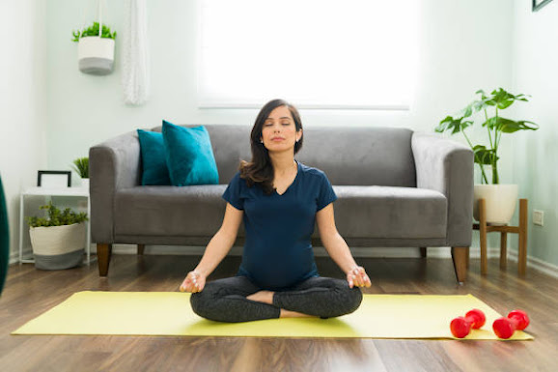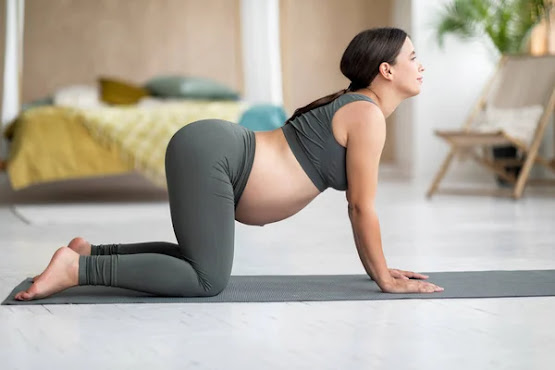Yoga Poses For First
Trimester Pregnancy
Note: Friends, if you want to read this article in any other language, please change the language from the translate button at the top of this article.
 |
| During the first trimester of pregnancy, it's important to choose yoga poses that are safe and suitable |
During the first trimester of pregnancy, it's important to choose yoga poses that are safe and suitable for the changing needs of your body.
Here are some recommended yoga poses for pregnant women in the first trimester:
1. Mountain Pose (Tadasana):
 |
| Mountain Pose (Tadasana) can be done during pregnancy |
To practice Mountain Pose (Tadasana) safely during pregnancy, follow these guidelines:
1. Stand with your feet hip-width apart:
Begin by standing with your feet parallel to each other, about hip-width apart. Distribute your weight evenly on both feet.
2. Align your body:
Lengthen your spine by imagining a string pulling you up from the crown of your head. Keep your shoulders relaxed and down, away from your ears.
3. Engage your core:
Gently engage your abdominal muscles by drawing your navel towards your spine. This helps support your growing belly and maintain good posture.
4. Modify your stance if needed:
As your pregnancy progresses, you may need to widen your stance slightly to accommodate your changing center of gravity. Adjust your feet to a comfortable position where you feel balanced and stable.
5. Use props if necessary:
If you're experiencing any discomfort or strain in your lower back or pelvis, you can place a folded blanket or yoga block under your heels to relieve some pressure.
This modification helps to tilt your pelvis slightly forward, providing additional support.
6. Breathe deeply and relax:
Take slow, deep breaths, allowing your belly to expand with each inhalation. Relax your facial muscles and any tension in your body.
2. Cat-Cow Pose (Marjaryasana-Bitilasana):
 |
| Cat-Cow Pose is generally safe to practice during pregnancy |
Cat-Cow Pose (Marjaryasana-Bitilasana) is generally safe to practice during pregnancy, but it's important to modify the pose to accommodate the changes in your body.
Here's how to do Cat-Cow Pose safely during pregnancy:
1. Start on your hands and knees:
Get onto a comfortable surface, such as a yoga mat, and come onto your hands and knees. Align your wrists under your shoulders and your knees under your hips.
2. Find a neutral spine:
Begin in a neutral spine position, with your back flat and parallel to the floor. Make sure your head is in line with your spine.
3. Cat Pose:
As you exhale, gently round your back like a cat, tucking your chin towards your chest and drawing your navel towards your spine.
This helps to stretch your back and release tension. Take care not to compress your belly.
4. Cow Pose:
As you inhale, lift your chest and arch your back, allowing your belly to drop towards the floor. Lift your gaze slightly, without straining your neck.
5. Flow between Cat and Cow:
Continue to flow between Cat Pose and Cow Pose, synchronizing your breath with the movement. Exhale as you move into Cat Pose and inhale as you transition into Cow Pose.
6. Modify for comfort:
As your pregnancy progresses, you may need to modify the pose to ensure comfort and safety. You can widen your knees slightly to make room for your belly or place a folded blanket under your wrists for added support.
7. Listen to your body:
Pay attention to any sensations or discomfort in your body. If you feel any pain or strain, reduce the intensity of the movement or skip the pose altogether.
Always remember to breathe deeply and stay mindful of your body's limitations.
3. Modified Triangle Pose (Trikonasana):
 |
| Modified Triangle Pose (Trikonasana) can be practiced safely during pregnancy with some modifications |
Modified Triangle Pose (Trikonasana) can be practiced safely during pregnancy with some modifications to accommodate your changing body.
Here's how to do Modified Triangle Pose safely:
1. Start in a wide stance:
Begin by standing with your feet wider than hip-width apart. Adjust your stance as needed to find a comfortable distance that provides stability.
2. Modify your foot positioning:
Turn your right foot out to the side at a 45-degree angle. Keep your left foot pointing forward or slightly turned in for better balance.
3. Adjust your body position:
As your pregnancy progresses, it's important to avoid deep twisting or compression of the abdomen. Instead of reaching all the way down to the floor, place your hand on your shin, a block, or a prop for support.
4. Extend your arms:
Extend your left arm up towards the ceiling, keeping it in line with your shoulder. Allow your right hand to rest on your right hip or thigh for added support and stability.
5. Lengthen your spine:
Engage your core muscles and lengthen your spine, creating space between each vertebra. Avoid leaning or collapsing into the pose.
Imagine a straight line extending from the crown of your head to your tailbone.
6. Gaze and breathing:
Turn your head to look up at your left hand, or keep your gaze straight ahead if it feels more comfortable. Take slow, deep breaths as you hold the pose, maintaining a relaxed and steady breathing pattern.
7. Repeat on the other side:
After holding the pose for a few breaths, slowly release and come back to the starting position.
Repeat the steps on the opposite side, turning your left foot out and extending your right arm up.
4. Warrior II Pose (Virabhadrasana II):
 |
| Warrior II Pose (Virabhadrasana II) can be practiced safely during pregnancy with a few modifications |
Warrior II Pose (Virabhadrasana II) can be practiced safely during pregnancy with a few modifications to ensure comfort and safety for you and your baby.
Here's how to do Warrior II Pose safely:
1. Start in a wide stance:
Begin by standing with your feet wider than hip-width apart. Adjust your stance as needed to find a comfortable distance that provides stability.
2. Modify your foot positioning:
Turn your right foot out to the side at a 45-degree angle. Keep your left foot pointing forward or slightly turned in for better balance.
3. Adjust your body position:
As your pregnancy progresses, it's important to avoid deep lunging or overstretching. Instead of a deep lunge, bend your right knee to a comfortable position that feels stable and supportive. Keep your knee aligned with your ankle.
4. Modify your arm placement:
Extend your arms out to the sides at shoulder height. Relax your shoulders and keep your palms facing down. If it feels more comfortable, you can rest your hands on your hips for added support and stability.
5. Lengthen your spine:
Engage your core muscles and lengthen your spine, creating space between each vertebra. Avoid leaning or collapsing into the pose. Imagine a straight line extending from the crown of your head to your tailbone.
6. Gaze and breathing:
Look over your right fingertips, or keep your gaze straight ahead if it feels more comfortable. Take slow, deep breaths as you hold the pose, maintaining a relaxed and steady breath pattern.
7. Repeat on the other side:
After holding the pose for a few breaths, slowly release and come back to the starting position. Repeat the steps on the opposite side, turning your left foot out and bending your left knee.
5. Supported Squat (Malasana):
 |
| Supported Squat (Malasana) can be a beneficial pose during pregnancy |
Supported Squat (Malasana) can be a beneficial pose during pregnancy as it helps open up the hips and relieve lower back tension.
Here's how to do a Supported Squat safely:
1. Find a comfortable position:
Stand with your feet slightly wider than hip-width apart, toes turned out at a comfortable angle. You can use a yoga mat or stand on a padded surface for added comfort.
2. Use props for support:
Place a yoga block, folded blanket, or bolster on the floor in front of you. This will provide support and stability as you lower into the squat.
3. Lower into a squat:
Bend your knees and lower your hips down towards the floor. As you descend, aim to bring your hips slightly lower than your knees. However, go only as far as feels comfortable for you.
4. Maintain alignment:
Keep your spine long and upright. You can place your hands together at your chest in a prayer position to help maintain balance and engage your core.
5. Adjust your feet if needed:
If you find it challenging to keep your feet flat on the floor or if you experience discomfort, you can slightly elevate your heels by placing folded blankets or yoga blocks underneath them.
6. Breathe and relax:
Take slow, deep breaths as you hold the squat. Relax your shoulders and allow your hips to open naturally.
You can gently rock side to side or forward and backward to find a comfortable position.
7. Modify the height of the support:
Depending on your comfort level, you can adjust the height of the prop under your hips. Start with a higher prop and gradually lower it as you gain flexibility and stability.
8. Be mindful of your body:
Listen to your body and respect your limits. If you feel any pain or discomfort, come out of the pose and try again with modifications or skip it altogether.
6. Easy Pose (Sukhasana):
 |
| Easy Pose (Sukhasana) can be practiced safely during pregnancy |
Easy Pose (Sukhasana) is a simple and gentle seated posture that can be practiced safely during pregnancy.
Here's how to do Easy Pose safely:
1. Find a comfortable seat:
Sit on a cushion, folded blanket, or yoga block to elevate your hips slightly. This helps to tilt your pelvis forward, supporting your spine and reducing strain on your lower back.
2. Cross your legs mindfully:
Cross your legs at the shins, allowing your knees to relax and lower towards the floor.
If crossing your legs is uncomfortable, you can extend one leg in front of you and bend the other leg, placing the foot on the inner thigh of the extended leg.
3. Align your spine:
Lengthen your spine by imagining a string pulling you up from the crown of your head. Keep your shoulders relaxed and down, avoiding slouching or rounding of the upper back.
4. Find a hand position:
Rest your hands on your knees or thighs, palms facing up or down, whichever feels more comfortable for you.
You can also bring your hands into a mudra (hand gesture) if you wish, such as placing the tips of your thumbs and index fingers together.
5. Close your eyes and breathe:
Close your eyes gently or soften your gaze. Take slow, deep breaths, allowing your belly to expand with each inhalation. Maintain a relaxed and steady breath pattern throughout the pose.
6. Modify as needed:
If sitting on the floor is challenging, you can sit on a chair with your feet flat on the ground, maintaining an upright posture.
7. Use props if necessary:
If you experience discomfort or strain in your hips or knees, you can use additional props such as blankets or cushions for support. Place them under your hips or knees to provide extra padding and alleviate pressure.
Always listen to your body and make modifications as needed.
If you have any concerns or complications during your pregnancy, consult with your healthcare provider before practicing the above yoga poses.
Attending prenatal yoga classes or seeking guidance from a qualified prenatal yoga instructor can also provide personalized modifications and support.
Friends, Stay Fit, Stay Happy
--------------------------------------------------------
Friends, if you liked it, please share it with your friends.
SHARING IS CARING.
Compiled by: Paramjit Singh Rana

Comments
Post a Comment